The 13 Sanity-Saving Tools I Use to Run my Business as a Solopreneur
The tools you use make a huge difference in your productivity and time management, but there are so many to pick from. Here are my top 13 tools I use every day.

Note: This post was originally published on 12.18.2018 with 10 tools. It was updated on 3.30.2020 with 3 new tools added.
I mentored a college class once, and after sharing about my business and life, a student raised her hand and said: “Gosh, it seems like you do so much between your business, volunteering, and everything else. How in the world do you do it all without going crazy?”
My answer was simple: TOOLS.
We’re lucky to live in a time when there are tools to help us streamline nearly EVERYTHING we need to accomplish. As the saying goes, whatever tool you need, “there’s [probably] an app for that.” And thankfully, for solopreneurs and small business owners, all the apps/tools/softwares can help preserve our sanity as we juggle wearing #allthehats while sustaining and growing our businesses.
My 4-Point Tool Philosophy
I have tried my fair share of tools on every scale out there – from enterprise-level monstrosities to simple personal plans – and I am quite picky because I know how tools can hurt or hinder momentum. The common thread of all the tools I use comes down to these four qualities:
- Intuitiveness – If it takes me more than a few minutes to figure out how things work and why, I immediately pass. It’s 2018, this should be figured out before the tool is out of beta.
- User interface and design – I prefer tools that have put a lot of thought and effort into the UI and design of their interface, which usually hints at the quality of the tool itself. If color coding can be involved, I’m a happy camper 😉
- Integrations – There’s no one tool that does everything (nor should it), so simple integrations with other tools is a must-have for me.
- Company Culture – I like company’s that practice what they preach and create great content and support to their prospects and customers. I’m often a big fangirl of my tools and happy to be an advocate for them if they’ve really helped me.
The tools you use really do make a difference in your productivity and time management, and while there so many out there, you want to make sure you are choosing the right ones for you and your needs. Don’t waste time on an app that everyone is using and talking about if it’s not right for you. Stick to what makes your life easier and make sure you thoroughly test everything before you buy.
Here are 10 major tools I use on a day-to-day basis, broken down by type and how I use them to run (and grow) my business. Do you have a favorite listed here or questions on one of them? Leave me a comment below!
1. Later
Instagram planning and publishing – Visit Website
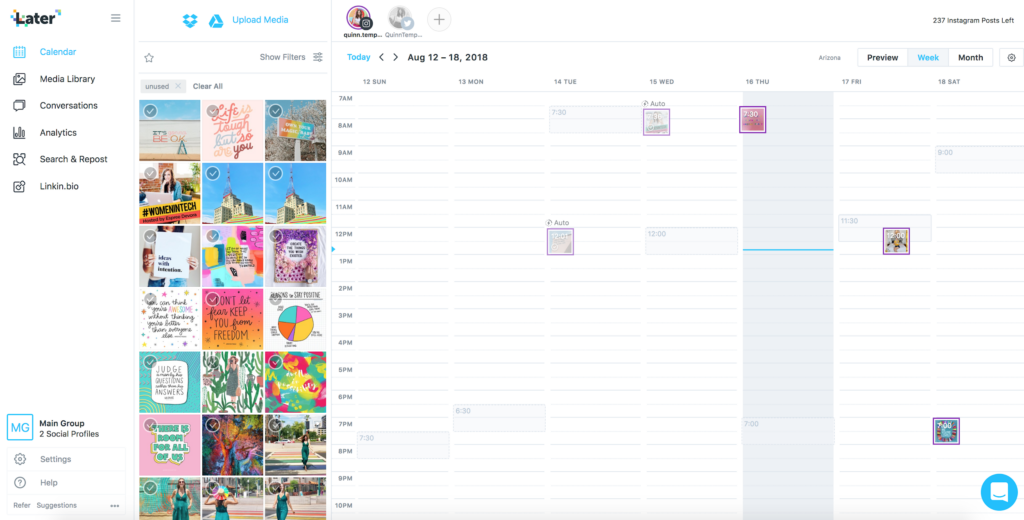
I use Later for all of my strategic Instagram planning. Unlike other apps, Instagram has so many idiosyncrasies not on other social platforms that having a tool that’s built specifically for the platform is crucial. Later also has some really great features that make scheduling a breeze, including:
- hashtag libraries
- media library filters and labels
- a drag-and-drop grid preview
- weekly and monthly calendar views of your scheduled content
- a conversation dashboard to monitor and respond to comments
- performance analytics
They’re also just a great company and produce awesome content and trainings. Out of many Insta-publishing tools, they are always one the first to release new features and are always on-top of algorithm updates that affect the tool.
Price: Free, or Paid plans start at $9/month
I have a paid plan in order to get advanced analytics.
2. CoSchedule
Editorial calendar and social publishing tool – Visit Website
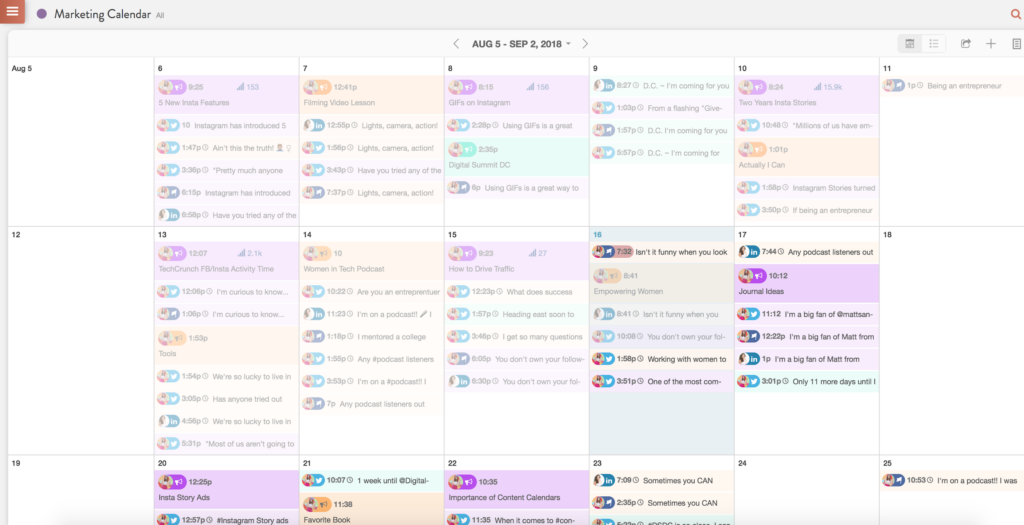
CoSchedule is what I use to plan all my content and social media (except for Instagram). It houses all of my social content publishing for Linkedin, Twitter, Facebook, AND my blog’s content editorial calendar as well. It integrates directly with WordPress, so you can publish and draft blogs right within CoSchedule. Email is a breeze too – it integrates with Mailchimp and other email providers too. There’s no other tool I know of that does this – brings your entire content marketing efforts into one beautiful calendar view and allows you to create the content right within the tool, eliminating opening 10 browser tabs to finish one task – WINNING!
Plus, it’s pretty. You can color-code to keep things organized, duplicate campaigns in a click, and see deep analytics by platform. I’ve used almost every social publishing tool out there and this is by far the most intuitive. It’s an investment that is hugely worth it if you have a robust content marketing plan in place (or want to create one!).
Price: Free 14 day trial, Plans start at $60/month
3. Asana
Project and task management – Visit Website
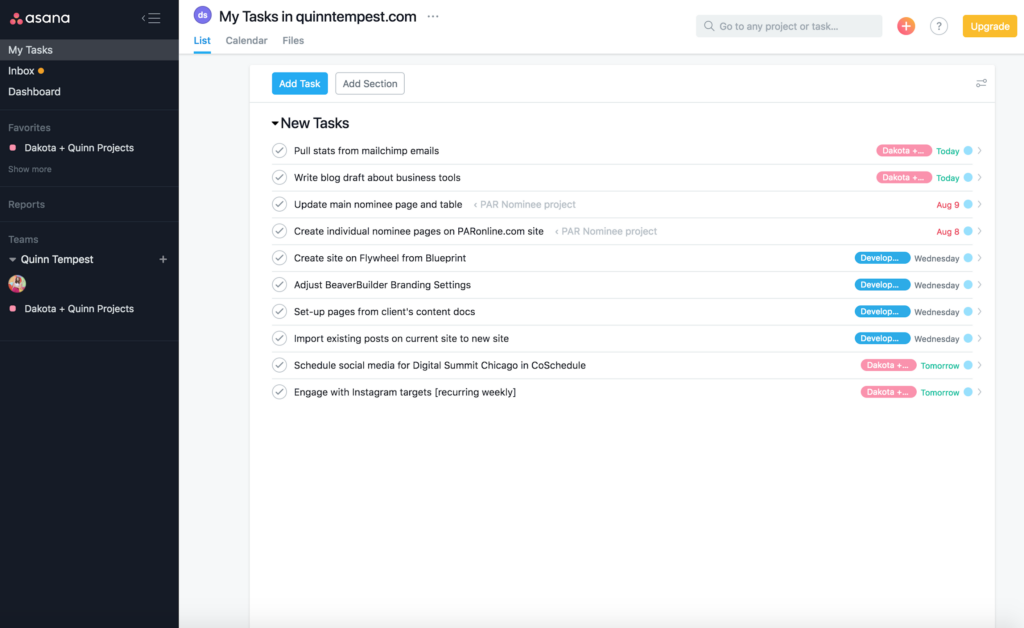
Asana. Saves. My. Life. This is my project management tool for literally everything I do in my business. I have a design to create? I assign myself a task and a due date. My client owes me content for their website? They get a task and a date. I need to follow-up with someone in 3 months? Future Task. Added.
Disclaimer: it does take a little bit of upfront work to set it up and you can’t just ‘dabble’ with a project management tool if you want to see real results. That being said, once you’ve got it set up and have settled into a daily routine, you will save time and clear out so much mental space because every task that needs to get done is saved in the tool and NOT your brain.
My clients now work with me inside Asana and I can’t tell you how happy that makes me. No more emails, just tracked conversations, tasks, and files all in one place, making it easy to find. Many of them have even set-up their own Asana after our projects because they love it so much.
Lastly, this is THE tool that has helped me scale my business. By creating project templates, I now have a set processes for all my main deliverables and I duplicate that for every client. I no longer have to wonder what comes next and when, and I’m able to work with contractors to step into certain element of the project so I can do what I do best – strategize and design.
Price: Free, or Paid Plans start at $9.99/month
The free version works perfectly for my needs, although I would give this company my money in a heartbeat.
4. Harvest
Time tracking and invoicing – Visit Website (Use QUINNSAVE50 to get half off your first month)

Give me the money, honey! Harvest is where all my financials for my business live. I am able to track my income and send out invoices that integrate with PayPal or Stripe for payment processing. It also Integrates with Asana so that I can track all my time by the task, which then ports over automatically so I can quickly and simply send an invoice. I also have a separate spreadsheet outside of Harvest where I track everything income/expense relate for no other reason that I like manually inputting my income and setting goals that way.
Price: Free with limited features, Solo Plan $12/month, Team $12/month per person
5. Calendly
Meeting Scheduler – Visit Website
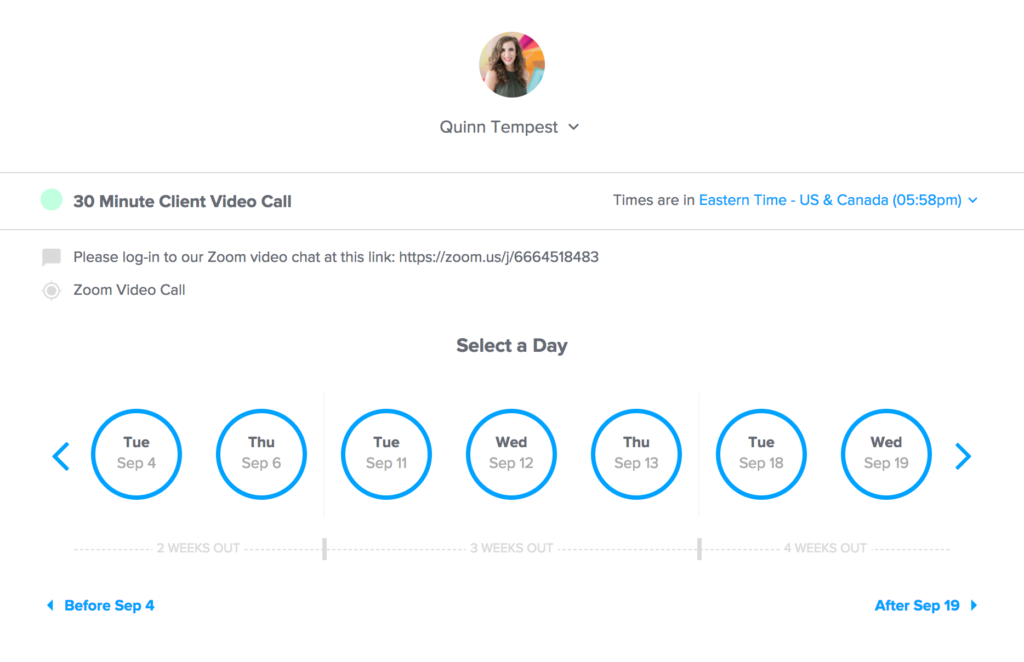
Gone are the days of going back-and-forth via email 5 times to set a meeting time that works for both parties. Looking back, I can’t believe how much time I must have wasted doing that.
Enter Calendly, the ultimate tool in scheduling meetings without the pain. All I do is make sure my normal Google calendar is up-to-date every week, and Calendly will automatically figure out my availability, blocking off times so no one can book me then. I have set-up multiple types of meetings like a 30-Min Intro Video Call or a 45 Minute In-Person Meeting, and I simply send a link to someone and tell them to find and book a time and day that works for them. They will then be sent confirmation and reminder emails, all without me doing a thing. I have multiple calls and meetings a week, so this paid off the cost almost immediately after I signed up.
Price: Free, or Paid plans start at $8/month
6. Google Suite / G-Suite
Email, calendar, file storage, collaboration – Visit Website
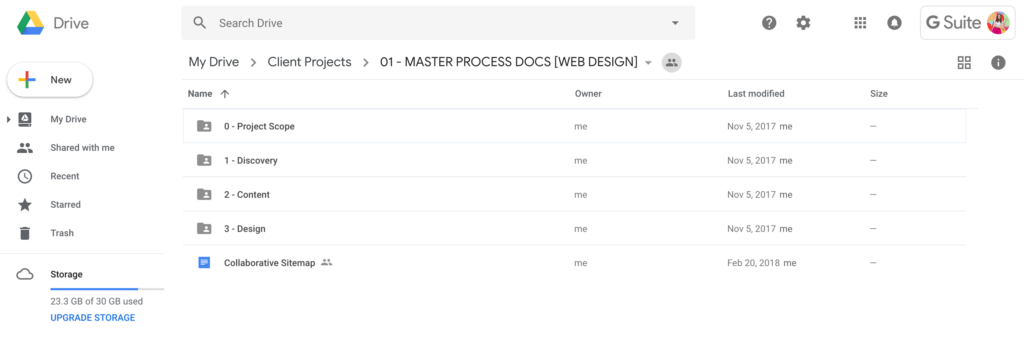
Google Suite is my go-to for fundamental operations: email, file storage, and calendar.
Google Drive is my file storage for things I need to collaborate on with clients or contractors. Because I am consistently creating content or am having my clients create content, and we are able to collaborate at same time in a document seamlessly, track changes, and carry on a conversation thread right in the document.
I also use Gmail for my email.
Price: Free, Paid plans start at $1.99/month
7. CloudApp
Video recording and screenshot cloud storage – Visit Website

I work remotely for the most part, and don’t meet my clients in-person unless they are local to Phoenix. So that means being able to communicate easily and visually is important, especially when I don’t want to write up a huge, long email.
Instead, I’ll just record a short video showing them my screen, maybe going over a mockup or walking them through a step-by-step process, and then I can upload it to the cloud and send them a link. On the backend, I can organize all my videos by ‘collections,’ which I group by client or project to make it easy-to-find. I also customized my video link, so it looks very official coming from http://videos.quinntempest.com!
Price: Free, Free Pro Plan 14-Day Trial, Paid plans start at $8/month
8. Upwork
Freelancer marketplace – Visit Website
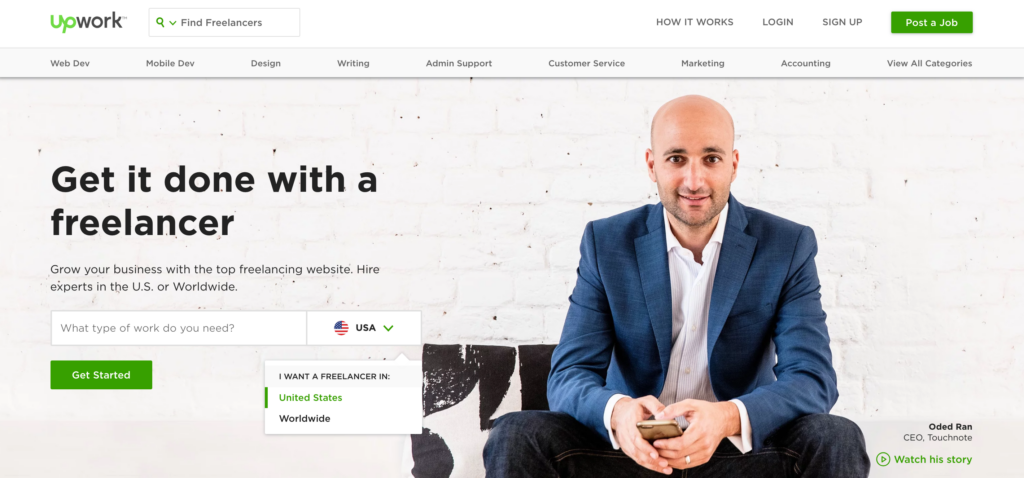
Upwork is where I’ve hired contractors all throughout my seven years of being an entrepreneur. Sometimes its for developers to help me build my sites and sometimes its just for administrative work. I had such great experiences finding people on here and I’d highly recommend to anyone wanting to start scaling their business. Just keep in mind that there are a lot of varying levels of expertise on marketplaces like this, so know what you’re looking for before you create a job listing.
Price: The service itself is free to sign-up for and Upwork adds a small fee to your payments for contractors.
9. Mailchimp
Email marketing and automation – Visit Website
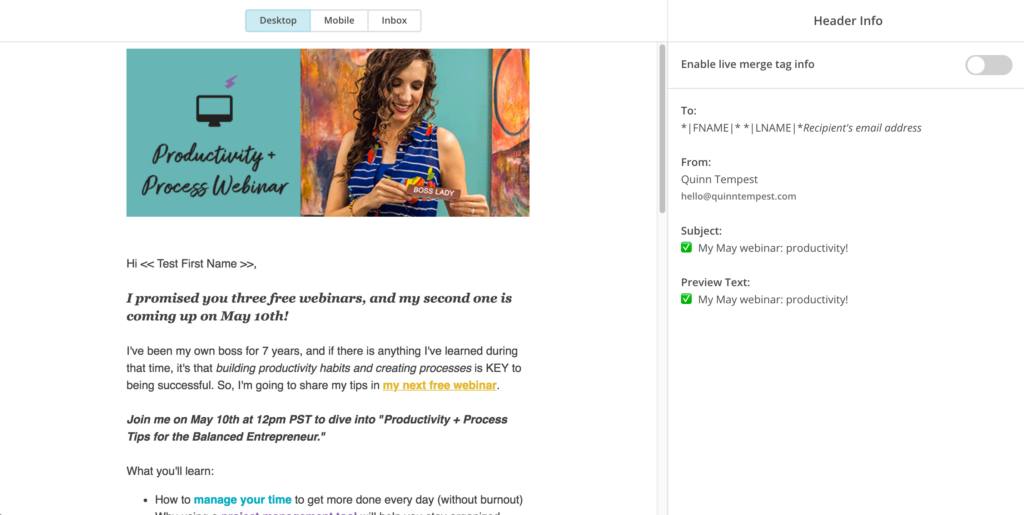
Who knew a monkey knew so much about email marketing? Mailchimp has been my go-to email marketing tool of choice for my own business and for my clients for years. They have continued to grow and expand features, and are another company I truly respect. It’s simple, intuitive, and easy-to-use for the beginner but robust enough for the advanced marketer. There’s so much content out there about other email systems (I’ve tried most of them), and I still come back to Mailchimp every time. With automations and deep analytics and simple template designs, Mailchimp really has everything you need to communicate with your customers and prospects.
Price: Free up to 2,000 subscribers, Paid plans start at $10/month
10. Dropbox
Cloud file storage – Visit Website
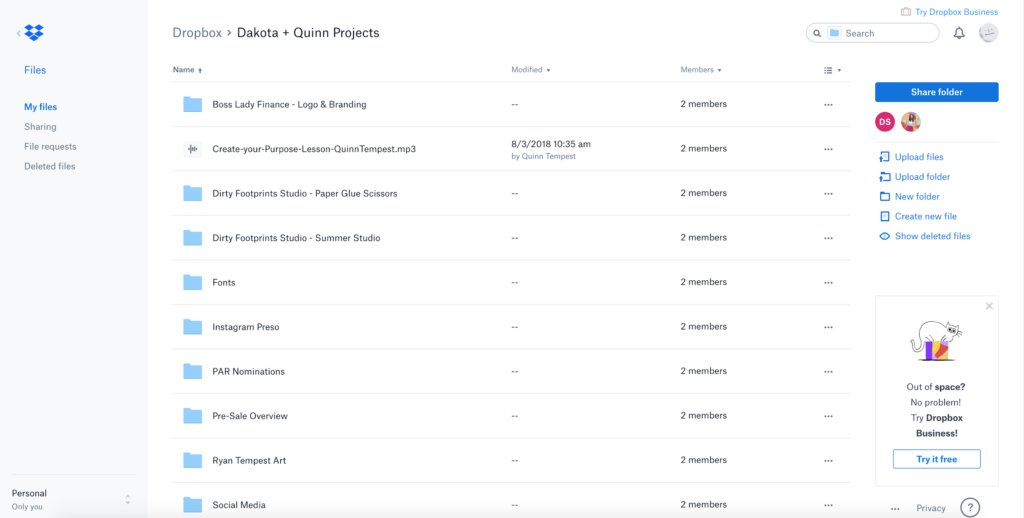
Dropbox is so integral to my business and used all the time, I almost forgot to include it on this list. As a designer and digital marketer, I have a lot of files – A LOT. And I can’t muck up my hard drive with everything going back for years, so I have my files synced to the cloud via Dropbox, as well as backed up to an external hard drive and another cloud storage service – better safe than sorry! I recently upgraded to a Pro plan which allows me to view all my cloud-synced files even if they aren’t saved on my computer. Having a good folder and file organization structure is key when using a tool like Dropbox so you’re not spending more time looking for files than you need to.
Price: 2GB Basic Plan Free, Paid plans start at $9.99/month
11. Linktree
Instagram Profile Link Tool – Visit Website
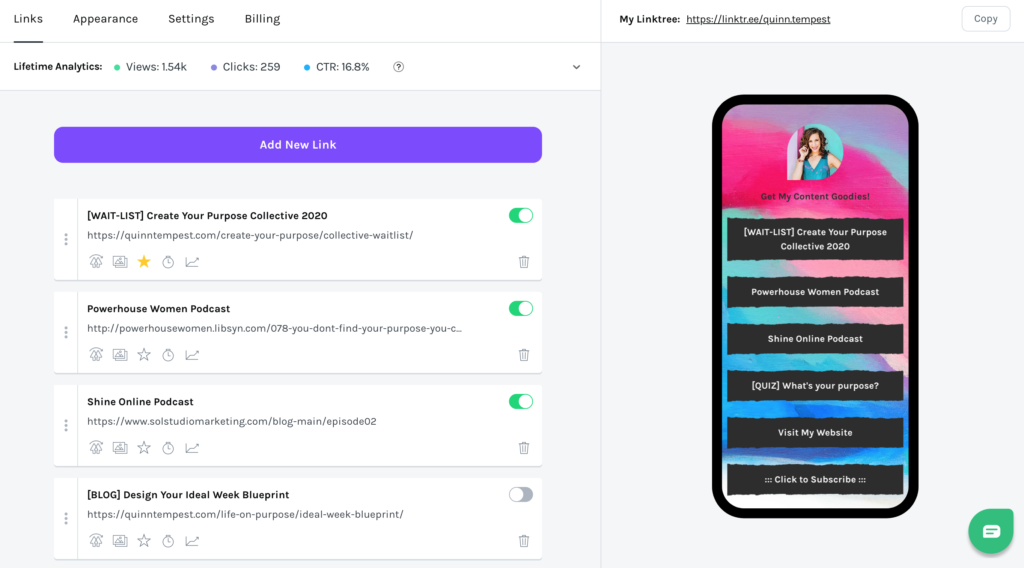
One of the most frequent questions I get asked when teaching Instagram marketing is, “What link-in-bio tool should I use to drive website traffic?” Linktree is my top choice due to it’s simplicity and intuitiveness. With it’s ability to link various forms of content, such as blogs, podcasts, etc, Linktree is well-suited to entrepreneurs, business owners, and content creators.
Because Instagram is my main form of marketing, I upgraded to the premium plan for more control over my landing page branding as well as the ability to have a Mailchimp integrated opt-in form right on the link page. However, the free version is great if you’re testing out tools trying to find the perfect fit for you.
Price: Free, Premium plan $6/month
12. Crowdcast
Live Streaming Platform – Visit Website
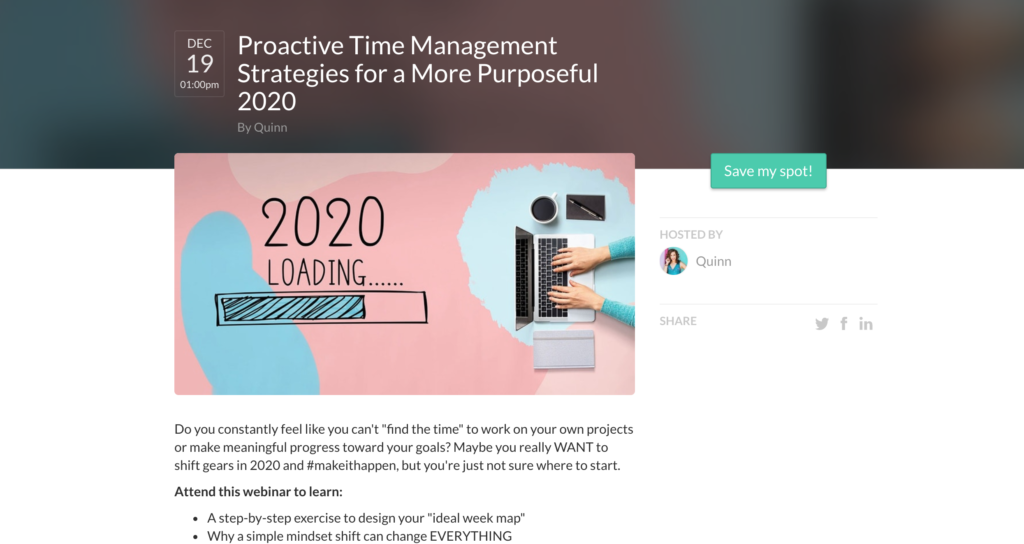
If you’re in search of a platform to host live, interactive conferences or events, then Crowdcast gets my vote. I use this to host both public-facing webinars and private masterclasses for my Collective. After testing multiple platforms and even committing to a different one before Crowdcast, I find this platform to be the most intuitive, easy-to-use for me and simple for my attendees.
Connect with your community by hosting a summit, perform live interviews for your audience, and create engagement through live Q&As, polls, and chats. Plus, allow those who missed the live event to watch replays when their time permits.
Price: Annual prices range from $20-$139/month.
13. Zoom
Video Conference Calling – Visit Website

I’m on Zoom at least once a day. I’ve never been a phone call kind of gal, preferring video calls to just audio, so this is perfect for me. I have calls with prospective clients, current clients, and the members of my Collective.
The free, personal plan is pretty extensive, allowing up to 100 participants and an unlimited number of meetings, with all of the video and audio conferencing features. One limitation of the free plan is you can only have group meetings for up to 40 minutes where people can all talk to one another. I need longer, so I have a paid plan. Plus, it integrates directly with my Calendly tool mentioned above, so as soon as someone schedules time with me, a Zoom link with instructions is also generated and sent.
Price: Free for personal meetings, Paid plans range from $14.99 to $19.99 per month per host.







Hi again Quinn,
Great post. Always curious how others manage it all in solopreneur situations.
Question: I use CoSchedule as well – although still not a pro at it. But pretty surprised to see that you also use Later rather just posting directly to IG from CS. I guess there’s so much more functionality that it makes it worthwhile to jump back and forth, and pay more?
Also, do you not use the task tool in CS for your content? I struggle with forcing myself to put everything in ONE tool (for me that’s ToDoist) vs being able to keep my content related tasks in CS and use templates connected to each project there (but not having visibility in my ToDoist app) in that case.
Thanks so much,
~Miriam
P.S. Totally surprised that you don’t have other comments on this post 😀
Hi there – I’m glad you found this post useful! CS is not a great tool for Instagram. Later has SOOOO many amazing rich features because it was built for IG specifically and understands its idiosyncrasies. Check out all my blogs on Later and you’ll see why. I recommend all my clients use Later for IG because other tools just aren’t built for it. I don’t use CS for tasks – in fact, I’m sure I don’t use a lot of cool features it has. I use Asana for my task management software 🙂